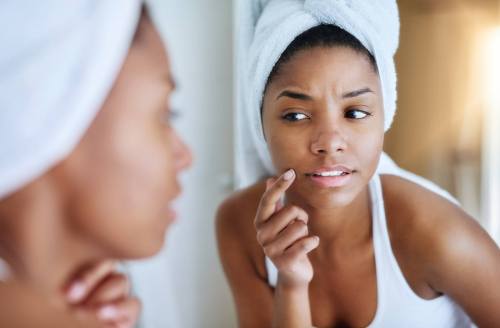Let’s play a little game I like to call ‘lip pimple or herpes?’
If you're all caught up in the cold sore vs pimple about that red bump on your lip, don't be. Here's how to tell the difference, according to a derm.

Seeing a red bump emerge on your lip line can instantly send you into straight-up panic-mode, and Google isn’t the most reassuring BFF when it comes to figuring out whether you’re dealing with a painful pimple or a cold sore. But you can finally stop scanning through pictures and take a deep breath: A dermatologist is here to help decipher the problem, once and for all.
While a lip pimple and cold sore might look similar, they’re actually very different. A pimple is generally caused when hair follicles “get clogged, fill with dead skin cells and sebum (oil), and then get inflamed,” says New York City-based dermatologist Dendy Engelman, MD. Cold sores, on the other hand, are caused by the herpes simplex virus—the same virus responsible for genital herpes—and can be due to either HSV-1 (the stain more closely related to cold sores) or HSV-2 (the strain more closely related to genital herpes). “The flare-ups of cold sores can be triggered from stress, sun, fever, or other external factors,” she explains. So, how can you tell the difference between the two by appearance alone? Keep on scrolling.

How to tell the difference between lip pimples and cold sores
When you have an angry red bump on your lip, it can be hard to figure out what’s going on with your skin. There are some very specific differences between lip pimples and cold sores, though. Once you contract the herpes simplex virus, it’s always in your system—there’s unfortunately no current cure. According to Dr. Engelman, the virus stays dormant until it’s triggered, and at that time you’ll start noticing the symptoms. “The wound is filled with fluid and has multiple bumps. Once they burst, they scab over before healing. Cold sores usually have a larger surface area than a lip pimple,” she says.
This Parisian Skincare Brand Is Launching in the United States for the First Time—Here’s What a Derm Wants You to Know

We’re Calling It: Cleansing Balms Are the Face Wash of the Future—Here Are 3 to Add to Your Cart

This Is the One Product That Scarlett Johansson Always Keeps in Her Purse and on Her Bedside Table

A lip pimple, on the other hand, is a whitehead with one raised bump that’s white in color—not multiple bumps, like you’ll see in a cold sore. “A whitehead has a thin layer of skin covering the pore, trapping the plug beneath the pore’s surface,” Dr. Engelman says. “Since the oil in the pore is not exposed to oxygen, it remains white or yellow—the natural color of sebum and dead white blood cells (or pus).” In terms of pain, though, neither one of these is going to feel good: “The lip area is sensitive, so both can be painful depending on where they’re located, however cold sores hurt more. They can tingle, burn, or itch,” she explains.
How to treat lip pimples
Since you’re working with a sensitive area, you have to make sure you’re properly treating your lip pimple correctly—and that means no popping. Instead, Dr. Engelman recommends using products you can find right at the drugstore. “Since this type of acne is considered mild, over-the-counter products that contain ingredients such as salicylic acid, benzoyl peroxide, and retinol should do the trick,” she says. “These products work by killing bacteria, drying excess oil, and forcing the skin to shed dead skin cells.” Try incorporating an OTC retinol like the Envy Medical Trifecting Night Cream 1.0 ($95) or dab on the benzoyl peroxide-spiked Glossier Zit Stick ($14).
How to treat cold sores
Cold sores might be a little harder to treat than a lip pimple, but there are a few different things you can do to make the process fast and pain-free. “To manage pain, apply a cold compress and take an oral pain reliever. On the site, Abreva is an over-the-counter option that claims to minimize pain and expedite healing. It works to contain the virus, which helps it to heal faster,” Dr. Engelman says. “It’s also important to keep the area clean to ensure no further infection. I like witch hazel since it’s a natural astringent that can control inflammation, decrease oil, and redness. It has astringent properties, so with application, it can help temporarily minimize the appearance. Vasoconstriction can minimize redness and anti-inflammatory and anti-septic properties with help with healing.”
And if nothing you’re doing at home is making a difference, Dr. Engelman says it’s best to contact your derm to discuss the option of getting on an anti-viral medication—like Valtrex or Sitavig—to treat the virus. No matter what problem you’re having, with a little TLC, you’ll be left feeling like yourself again soon.
How long should you actually leave on those acne-busting hydrocolloid patches? Or, find out how to get rid of back acne holistically.
Sign Up for Our Daily Newsletter
Get all the latest in wellness, trends, food, fitness, beauty, and more delivered right to your inbox.
Got it, you've been added to our email list.







